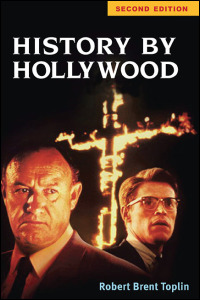| Robert Brent Toplin, History By Hollywood (2nd ed). Urbana: University of Illinois Press, 2010 ISBN: 978-0-252-07689-3 (US)$25.00 (pb) 280pp (Review copy supplied by University of Illinois Press) |
 |
When the first edition of Robert Brent Toplin’s History by Hollywood was published in 1996, the book was among a cohort of publications that interrogated the relationship between film and history. Some of the others included Robert Rosenstone’s valuable Visions of the Past (1995) and Past Imperfect (1995), the collection of essays edited by Marc C. Carnes. This second edition of Toplin’s book remains substantially the same as the first edition. It consists of eight case studies, each focused on one film: Mississippi Burning (1988), JFK (1991), Sergeant York (1941), Missing (1982), Bonnie and Clyde (1967), Patton (1970), All the President’s Men (1976), and Norma Rae (1979). The case studies engage with the same question, namely: How does production history help us to better understand, and better judge, filmmaker’s use of historical events to tell compelling stories? New to this edition is an updated introduction, which includes a section devoted to the defense of “cinematic history” as practice, and a discussion of several films released since the first edition, including the notorious Pearl Harbor (2001) and the controversial The Reagans (2003).
Each of the case studies is clearly-argued, responsibly researched, and appropriately contextualized. The book’s organization and readability makes it particularly appropriate for use in teaching. Each of the chapters summarizes each film’s production history and reconstructs the critical debates (in mainstream newspapers and scholarly journals) at the time of the film’s release. When assigning these chapters, however, teachers should take into consideration their students’ perspective. Although many of these films felt contemporary in 1996, they are now not just historical narratives, but are also historical artifacts. The most recent film then, JFK (1991), is now twenty years old. As we lead these conversations, we may need to refocus our own historical lenses. We might, for example, use the work on contemporary Hollywood to contextualize these films. With the exception of Sergeant York, all of these films were released between the late 1960s and early1990s, a period that includes the rise of American New Wave as well as its envelopment into the reconfigured, corporate studio system. We may want to ask how these industrial shifts effected the production context in which these historical narratives were crafted. A framework like this one would provide a historical framework for the films, and it would help to motivate the choices of these eight films, which are otherwise not tightly connected (although Toplin does argue for a genre category that he calls “cinematic history.”)
The film studies teacher will find much to use here, but the film studies scholar will be disappointed that there is so little formal analysis in Toplin’s studies. Attention to form would deepen his analysis without undermining his arguments. To use Mississippi Burning as an example: Toplin argues convincingly that the film deviated unnecessarily from the historical record when it made white FBI agents the heroes of its narrative and when it portrayed police vigilantism as a Civil Rights Movement tactic. The filmmakers thus opened themselves up to criticism on the grounds of authenticity, and the film “represents a lost opportunity” to be remembered instead as a “movie that effectively portrays an important problem in human relations” (44).
In this chapter, Toplin usefully reconstructs the film’s production history in order to account for the changes in the screenplay, showing how decision-making by the screenwriter, the director, the producers, and the studio executives helped to shape the film’s historical narrative. This background helps explain how the film ended up telling the story that it tells, but it doesn’t explain how the film makes its emotional impact – and it strikes me that the impact on the viewer is a major reason that Mississippi Burning is worth paying attention to. While reading this chapter, I remembered that my negative response to this film was not only due to the narrative marginalization of the African American participants in the Civil Rights Movement. I responded, too, to black characters’ sustained construction by the camera as passive subjects in their own story. More analysis of the filmmakers’ methods of storytelling, in addition to analysis of the stories, would add an additional, and important, dimension to Toplin’s perspectives.
As Toplin rightly argues, the issue at stake is not whether cinematic history, as written by Hollywood, is right or wrong in its interpretation of real events. Whether more or less accurate to the historical record, filmic narratives circulate more widely than historical monographs that display the results of similar – if more tightly regulated – labor of collection and creation. Our job as scholars, then, is to continue to do what Toplin offers us here: to use films to help us ask and answer our own questions about history, Hollywood, and what to make of the relationship between them.
Claudia Calhoun
Yale University, USA
